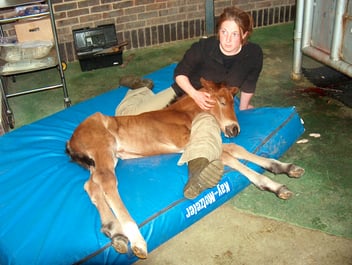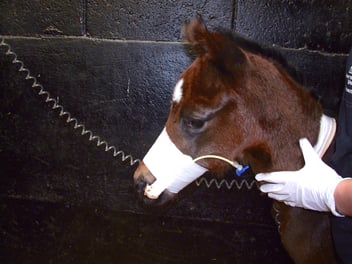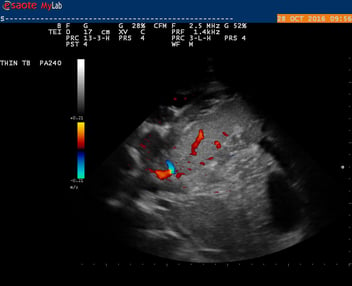Technique Tuesday - Placement of Temperature Reading Microchips
This Technique Tuesday, our co-founder and equine veterinary surgeon, Kevin Corley, is sharing his expertise on the Placement of Temperature Reading Microchips. Have questions or comments? Drop them in the comment form below, and Kevin will be more than happy to help! Stay tuned for more exciting insights and techniques.

Microchipping a foal
Placement of Temperature Reading Microchips
Equipment
Temperature reading microchip.Bluetooth enabled microchip scanner, that reads temperature microchips.
Makes that read these microchips include those sold under the names: Global Pocket Reader Plus (GPR+)®, Universal Worldscan Reader Plus (UWSR+)®, AFX-110® and others.
Microchips which measure body temperature are now commonly available in Europe, UK, Ireland, and the USA. The chips have proven to be safe, accurate and much safer for both staff and horses.
Temperature reading microchips obviously give a different measurement to rectal temperature. The microchips, if correctly placed, give a reading much closer to core body temperature and are therefore more sensitive. Being able to measure body temperature without contact with the animal offers a number of advantages.
- The number of staff required is decreased.
- The animal is not touched so the need for hand washing, disinfectant wipes etc for staff is reduced.
- Disease is not passed on by thermometers or faecal contamination on staff clothing.
EquiTrace founder Dr Kevin Corley shares his clinical experience on the best way to place these micro-chips and use these new microchips to get the best clinical results.
Technique
Unlike standard microchips the temperature reading microchips will work better if they are placed in muscle not ligament. The microchip is measuring the temperature in the animal’s blood so are obviously more accurate if in a vascular tissue like muscle. The microchip should be placed in the middle of the neck below the ligament nuchae. In adult horses the site for placement should be 5-6cm below the roots of the mane below where the firm border of the ligament nuchae can be palpated.
In foals this is 2-3cm below the roots of the mane.
Microchips read side on. The chip will read better if it is placed at a 45-degree angle to the skin rather than perpendicular. In adults the microchip should be placed to the full depth of the administering needle which contains the microchip. In foals, half the depth of the needle (1-2cm) is probably sufficient. The chip should not be subcuticular.
The goal is to the place it into either of the Semispinalis or Obliquus capitis caudalis muscles (shown on the diagram as a. and b. – diagram source)

The temperature reading microchip should be placed in either muscle a. (M. Obliquus capitis caudalis) or in muscle b. (M. Semispinalis) in the upper third of either muscle.
Trouble Shooting
Chip migration is not reported as an issue with the temperature reading microchips. The microchips are coated in BioBond® coating which helps the microchip embed into local tissue. The coating causes mild local inflammation to do this, which fades after 2-7 days. It is important to be aware of this as the local inflammation can cause the chip to read a little high for the first few days, after which it is accurate.
If a microchip is placed too shallow it may not read body temperature properly. If it is placed at 90 degrees to the skin, then the scanner may have difficulty picking up the identity number and temperature.
Scanners
Makes that read these microchips include those sold under the names: Global Pocket Reader Plus (GPR+)®, Universal Worldscan Reader Plus (UWSR+)®, AFX-110® and others.
The GPR+ is available here
Scanner quality is important. Low quality scanners can have shorter ranges and have to be held closer to the skin to detect the temperature and microchip number. To be able to connect to the EquiTrace App scanners must be Bluetooth enabled.
Interpretation of Results
The body temperature measured by microchips is not the same as rectal temperatures. You do have to get used to interpreting a different range of numbers. Having now had experience of looking at over 300,000 body temperatures measured with temperature chips what is clear is that ‘normal’ is different for each individual animal. Measuring a temperature with a microchip is contactless and safe. This allows more frequent temperature monitoring. Most farms using the microchips check temperatures at least twice a day if not three times. The EquiTrace App by plotting these readings onto individual temperature graphs allows a trend and fever ‘spikes’ to be very quickly identified. Once an abnormality is detected the animal can be isolated and fully examined. As well as detecting disease this more frequent accurate temperature monitoring has been used to detect impending foaling, ovulation, heat stress in competition and thermal comfort of animals in very cold environments e.g. commercial farms in Canada. Farms report that animals developing disease have demonstrated a change in their temperature graph two days before any other clinical signs. These changes were within the ‘normal range’ and without the EquiTrace App would not have been identified as abnormal. With the App foals could be isolated early preventing disease spread.




